The day after Superstorm Sandy virtually wiped out Misquamicut Beach, Lisa Konicki, the executive director of the Greater Westerly-Pawcatuck Area Chamber of Commerce, called an emergency meeting of the chamber’s board of directors. The result: a curious handwritten diagram comprising a circle within which are the words “Chamber’s Hurricane Sandy Recovery Efforts,” and 16 lines radiating out from the circle like spokes in a wheel. Each line is labeled with a recovery initiative: t-shirt sales, fundraising events, Small Business Development Centers (SBDC) satellite location, donation jars, Small Business Administration (SBA) satellite location, resident passes, $15,000 Jump Start grant, volunteer recruitment, media relations, meals for volunteers, town beach presence, supply recruitment, Rhode Island Economic Development Corporation (RIEDC) satellite location, information hub, donation of staff time and meetings/advocacy.
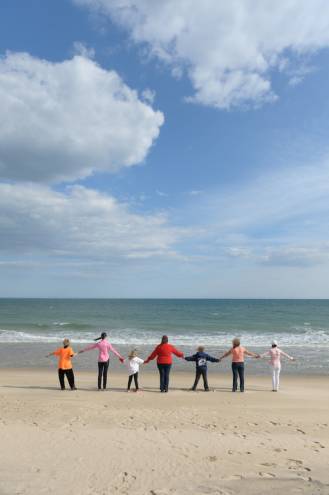 The diagram, taped to the wall in Konicki’s office, would turn out to be the foundation of the recovery effort. The chamber kicked off the “Bring Back the Beach” program. A cornerstone of the program is raising money for businesses to use to rebuild by collecting donations and selling t- shirts and hoodies emblazoned with the program’s logo: a pair of hands forming a heart with the beach in the background. Konicki, an energetic mother of three, managed to get Charlie Watts of the Rolling Stones to sign a few hoodies for auction.
The diagram, taped to the wall in Konicki’s office, would turn out to be the foundation of the recovery effort. The chamber kicked off the “Bring Back the Beach” program. A cornerstone of the program is raising money for businesses to use to rebuild by collecting donations and selling t- shirts and hoodies emblazoned with the program’s logo: a pair of hands forming a heart with the beach in the background. Konicki, an energetic mother of three, managed to get Charlie Watts of the Rolling Stones to sign a few hoodies for auction.
The response was astounding. Konicki keeps a three ring binder with copies of the checks and letters that came pouring in. A restaurant in Florida collected donations from the staff and sent a check with a handwritten letter attached:
On behalf of the Little Bar Restaurant in Goodland, FL, the staff is making a donation in the name of the owners, Ray and Amy Bozicinik and Nicki Bauer. We hope this will help the victims of Sandy. Wishing you all a happy holiday and a better 2013.
Sincerely,
Maureen Salliman
A $1,400 check was sent in from a couple from Wilmington, North Carolina. A $30 check from a woman in Warwick came with this note attached:
To help for the rebuilding of the area. This donation is my cousin’s Christmas present. We love this area and enjoy it in the summer.
 Konicki set a high bar for the chamber’s fundraising efforts: $400,000 by May 31, 2013. On the day I visited her office, April 5, the total was $344,246.96. Along with donations, money came pouring in from everywhere: a bake sale, a haircut-a-thon, a neighborhood yard sale put on by children, a memorial fund, a karate break-a-thon, a Zumba-thon, a bowl-a-thon, a grease recycling program, Naval officer donations and sales of a Grey Sail beer specially made for the recovery effort. Donations poured in from foundations and businesses: $45,000 from the Royce Family Foundation, $15,000 from Washington Trust, $10,000 from Valenti Toyota and $3,000 from the Weekapaug Fire District, to name just a few. The list is extensive.
Konicki set a high bar for the chamber’s fundraising efforts: $400,000 by May 31, 2013. On the day I visited her office, April 5, the total was $344,246.96. Along with donations, money came pouring in from everywhere: a bake sale, a haircut-a-thon, a neighborhood yard sale put on by children, a memorial fund, a karate break-a-thon, a Zumba-thon, a bowl-a-thon, a grease recycling program, Naval officer donations and sales of a Grey Sail beer specially made for the recovery effort. Donations poured in from foundations and businesses: $45,000 from the Royce Family Foundation, $15,000 from Washington Trust, $10,000 from Valenti Toyota and $3,000 from the Weekapaug Fire District, to name just a few. The list is extensive.
There were also two remarkably successful fundraising events. Joyce Olsen Resnikoff, the owner of Olde Mistick Village, in Mystic, Connecticut, organized a cocktail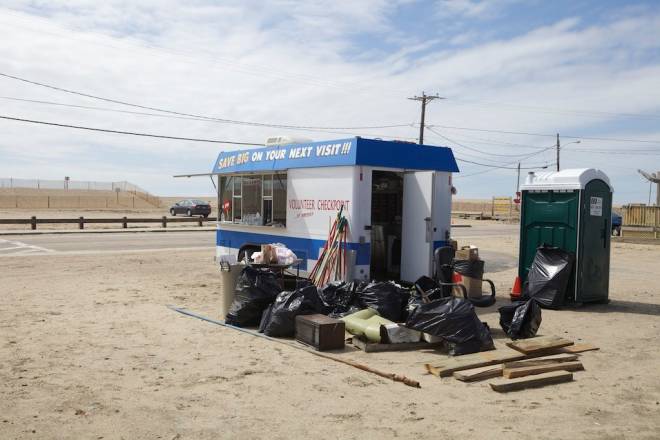 party. In what seems a nearly impossible feat, $57,000 was raised in seven minutes. “The party started at 4pm,” says Konicki, “and literally by 4:07pm we had raised $57,000.” On February 23, a staggering $102,000 was raised at the Black and White Ball at the Ocean House in Watch Hill.
party. In what seems a nearly impossible feat, $57,000 was raised in seven minutes. “The party started at 4pm,” says Konicki, “and literally by 4:07pm we had raised $57,000.” On February 23, a staggering $102,000 was raised at the Black and White Ball at the Ocean House in Watch Hill.
Konicki first told me this story over the phone. Her voice cracked, and she asked for a moment. After collecting herself, she said, “The support has been overwhelming.”
Headquarter Creation
Barbara Stillman, owner of the Atlantic Beach Casino, longtime Misquamicut resident, and, as some say, the “mayor of Misquamicut,” can usually be found at the RV she’s parked at her property. The RV serves as the hub, or as one business owner put it, “the social club,” for local business owners, a place where they gather for drinks nightly to cry, laugh and hug. There is a fridge stocked with beer and wine. Norm Dufresene, whose food hut, called Sam’s, was obliterated, said, “There’s always someone in pain, so we needed a place to cry and commiserate.”
Stillman, an intense, deeply tanned woman with reading glasses hanging from the tip of her nose and a distinct Rhode Island accent, spent the bulk of their time together in the social club fielding phone calls and greeting visitors. She was one of the first to survey the damage wrought by the storm. Unable to get to her property, she called a friend with a plane, “I want to go up. Now.” So up they went. The sight was devastating: “The ocean and pond were connected,” she said as I thumbed through pictures she’d taken from the air. “I called Norm and told him, ‘you’re not there.’”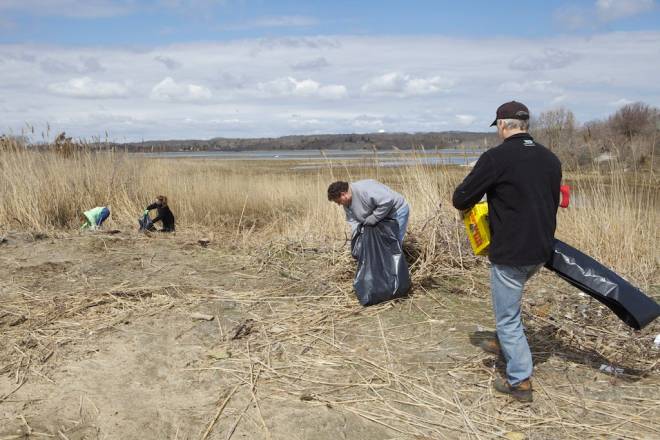
Atlantic Avenue, the main drag that runs along the narrow spit of land separating the Atlantic Ocean from Winnapaug Pond, was buried under five feet of sand. The massive storm surge rushed northwesterly across this tiny sliver of land, taking with it homes, businesses, decks, septic systems, refrigerators, you name it, and, oddly, it dumped the bulk of the mess nearly half a mile away, on the north shore of the pond. Stillman was sick to her stomach when she got off the plane. Her home, the place she loved, was gone.
Fueled by adrenaline, Stillman didn’t sleep for a week after the storm. A friend of Konicki’s, she went to the emergency meeting of the Chamber’s board of directors. “The chamber, which is really just Lisa [Konicki], acted, while the town seemed shell shocked,” she says. “Lisa just took charge, and told the board what needed to happen.” She pulls out a copy of the wheel and spoke diagram. “This is what she did.”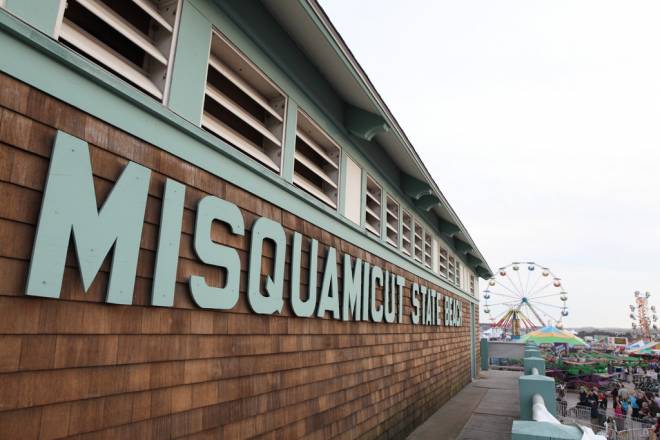
Stillman lost all of her utilities. Her water, septic system and electrical infrastructure were washed away. Her decks were gone, her pool filled with sand and sewage. It’s been a struggle to recover in time for summer. Her electricity only came back in mid- March, after spending $65 a day running generators for the contractors at her property. National Grid wasn’t much help; as she tells it, she had to corner the National Grid guy in his truck to get him to sort out her power. The septic system, not covered under insurance, has been one of the biggest pains. She’s gone back and forth with Rhode Island Department of Environmental Management (RI DEM), and still hadn’t received approvals to install a new septic system.
Insurance hasn’t paid a dime. “All of the funding has come from the Chamber and from my own savings.” Norm, who’d been listening intently to Stillman, chimed in, “The thing is that it’s 1,000% Lisa. The bulk of the businesses the Chamber has provided money for aren’t even members.”
Konicki, sitting next to me on a bench seat in Stillman’s RV, blushes. “Well,” she says, “it’s about doing the right thing.”
A Force of Nature
Misquamicut Beach is no stranger to disaster. In fact, we can thank disaster for what is now the state beach area, which was created in 1959 after the hurricanes of 1938, 1944 and 1954. According to the RI DEM website, the “slate was wiped clean” by these hurricanes, and “just about every structure along the beach was flattened, washed out to sea or damaged to the point of being uninhabitable.” The state was fed up; after Hurricane Carol, in 1954, legislation was passed to allow the state to condemn the beach and acquire it via eminent domain. The one-mile strip of state beach is the result.
But many homes and businesses remain alongside this strip. Packing a record breaking storm surge, Superstorm Sandy leveled or damaged hundreds of homes and 31 businesses. Sand dunes were simply gone. In the end, a contractor hired by the Town of Westerly cleaned up, stockpiled, sifted and redistributed nearly 67,000 cubic yards of sand. Massive mounds of sand were stockpiled in the state beach parking lot. It was painstakingly sifted through to remove rocks, gravel and debris. Redistribution of the sand, to the beach and to public lots, was completed by April 1, the deadline set by the US Fish and Wildlife Service in order to avoid adverse impacts to the piping plover.
The sand on the beach is now pristine. The dunes are back. The only remaining debris in the state beach parking lot is the colossal mound of gravel sifted out of the sand.
Volunteers Heed The Call
“Volunteers were like angels.” This is what Konicki told me on our first phone call. To date, an astounding 1,200 volunteers have been mobilized to help businesses and homeowners clean up debris, shovel sand and repair structures.
The volunteers were mainly recruited by Serve Rhode Island, a non- profit organization headquartered in Providence, that, according to its website, “connects thousands of volunteers to service opportunities in the community annually.” The Chamber raised funds to provide the volunteers with lunch, tools and safety equipment. The Misquamicut Business Association managed volunteer efforts on the ground.
One recent sunny Saturday morning, the beach was bustling with contractors and volunteers, who mainly work on the weekends. Stillman and Konicki were hanging out at the social club, Stillman’s RV. Four volunteers were working at Stillman’s
volunteers, who mainly work on the weekends. Stillman and Konicki were hanging out at the social club, Stillman’s RV. Four volunteers were working at Stillman’s
property that day. Konicki, clad in gym gear, recommended I talk to one in particular. She told me his story. “He called me the first day and asked how he could help. He started by making cold calls for donations for the Bring Back the Beach fund. Then he went to the field and he’s been coming here every weekend since.”
Konicki escorts me onto Stillman’s property and introduces me to him. His name is Mick Manfredi. He’s married, has two kids and is in his 30s. He tells me he started making phone calls for donations on behalf of the Chamber. Then he delivered lunches to the volunteers. Then he got involved with Serve RI and he’s been helping with clean-up and rebuilding ever since. Manfredi, who was laid off prior to the hurricane, tells me that one of the most satisfying moments was when a total stranger walked up to him one day and thanked him. I ask what drives him to volunteer. “This beach was my life during the summer.” Konicki, back in the RV, echoes this sentiment. “Everybody loves this beach. There’s a strong emotional connection to it.”
Across the street from Stillman’s RV was the Misquamicut Business Association’s volunteer check-in trailer, manned that day by Julie Cardinal. While we talked, volunteers, including a mother and a daughter, streamed in and filled out the required paperwork. Cardinal directed them where to go.
There were 20 volunteers working that day. Many of them were working with Bernie Beaudreau and Cindy Myers of Serve RI to clean up the massive debris field on the north side of Winnapaug Pond.
According to Cardinal, this is about an average day; typically, around 20 volunteers toil away each weekend. Most of them, she says, are not from the area. A life long Misquamicut resident, Cardinal notes, “It’s the most amazing thing in my life.”
Caswelle Cooke, the executive director of the Misquamicut Business Association, arrives. He tells me that the MBA lost many of its programming materials in the storm. This included equipment used to put on their weekly summer events and seasonal events, including Springfest, which was held May 10-12. Nearly $8,000 dollars was raised in one week by the MBA to replace almost all of the equipment.
“The governor,” Cooke says, “has been awesome. He pays attention.” He told me that the Westerly Town Manager Steven Hartford and Governor Chafee spoke at length after the storm. The talks were invaluable to business owners: regulators from the RI DEM, the Coastal Resource Management Council (CRMC) and the town got together and visited businesses, saving loads of time and money associated with coordinating the permitting process. He tells me that MBA volunteers helped clean 200 cottages after the storm. “Also,” he says, “Home Depot has agreed to replace the 50 street planters that were lost.”
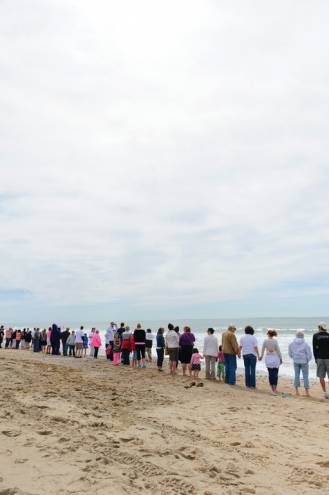 The Community Comes Together
The Community Comes Together
I tracked down Bernie Beaudreau on the north side of the pond. Beaudreau, the executive director of Serve RI and native Rhode Islander, was wearing jeans, muddy boots, a tattered sweatshirt and work gloves. A knot of volunteers huddled around a table eating sandwiches donated by Subway. Cindy Myers, also of Serve RI, is there as well. Myers, who previously worked at Johnson & Johnson, has been instrumental in sorting out the Serve RI volunteers on the ground.
While we walk down a path towards the debris field near the water, they run through the numbers. About 1,200 volunteers have spent about 6,000 hours on the clean-up effort – Serve RI’s biggest relief effort to date. About a quarter mile of pond shoreline had been cleaned, and about one and a quarter mile remain to be cleaned. Twenty-five tons of debris, including, incredibly, a couple of refrigerators, have been removed. “The big breakthrough came when the town and the Federal Emergency Management Council (FEMA) agreed to pay the tipping fees,” says Beaudreau.
“The community response has been incredible,” says Myers. “We got 2,500 applications from volunteers.” We arrive at the shore, where the wind is cold and brisk. Beaudreau points out the extent of the debris field. The next big push will be cleaning up a large section of shore to the east. The difficulty will be getting the debris from there to here; the distance renders carrying debris infeasible. The plan is to load the debris onto a large raft attached to a boat and ship it to where we are standing. From this point, the debris can be loaded onto a truck and driven up the path to the dumpster. Beaudreau hopes to utilize the Exeter Job Corps, a job training program for disadvantaged youth, to build the rafts.
Their work is cut out for them: Beaudreau estimates that about 100 tons of debris remain scattered along the shore. It’s a daunting task.
The Challenges of Reopening
Miraculously, all but one of the 31 impacted businesses, the Andrea Hotel, plan to reopen for the summer season. This is in no small way directly related to Konicki’s fundraising efforts. Twenty-nine businesses have received funding from the Bring Back the Beach program. Funding is distributed monthly and Konicki personally delivers the checks.
I went along with Konicki on one of her monthly check delivery routes. She was scheduled to visit, among others, Paddy’s, Windjammer and the Sea Shell Motel, distributing over $30,000 on this one day alone. The total to date that has been granted to businesses: over $330,000.
The first stop is the Sea Shell Motel on Winnapaug Road. Only a small backyard separates the pink and white two-story building from the pond. Several contractor trucks are parked in the small parking lot when we arrive. Tom Riley, the owner, emerges from one of the ground floor rooms covered in dust. He looks tired, but his face noticeably brightens when he spots Konicki. They exchange easy pleasantries like old friends. Konicki hands Riley an envelope. Holding off tears, he manages a small ‘thank you’ and wraps Konicki in a bear hug.
He’s been working around the clock to get the motel back up and running in time for the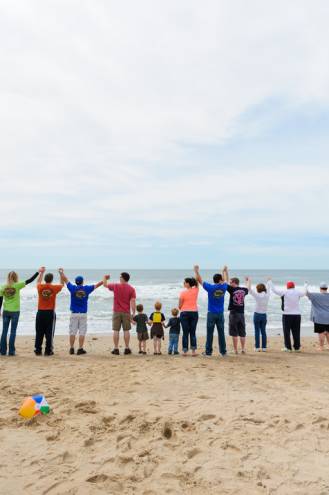 summer season. He had to gut the entire first floor of the hotel. He points to a brown line just under one of the door knobs on an exterior door: “That was the water line.” The storm surge rushed over the pond and struck the back of the motel, depositing all manner of debris in the small backyard.
summer season. He had to gut the entire first floor of the hotel. He points to a brown line just under one of the door knobs on an exterior door: “That was the water line.” The storm surge rushed over the pond and struck the back of the motel, depositing all manner of debris in the small backyard.
He spoke of insurance woes, and battles with the bank to save his business, his livelihood. Lloyd’s of London, who carried his wind policy, was, he said, “absolutely useless.” He went on, “We had a lawyer look at the policy, and he said that the way it’s written makes it virtually impossible to make any claims against it.” Riley is considering suing his insurance broker. He received a little money from Travelers, his flood insurance carrier, but not before a battle with the bank.
The property is mortgaged by Newport Federal. A clause in the mortgage stated that the bank could take any insurance proceeds paid out on the property. According to Riley, two days after the storm he and his wife received a letter from the bank stating that “they will consider whether or not to take any insurance proceeds.” Konicki adds, “You’ll hear stories like this from almost all of the business owners.”
“Basically,” says Riley, “they sent us a letter telling us they haven’t decided whether or not to put us out of business.” At one point, one of the two checks that Travelers sent was held up at the bank, and the Rileys were running out of money. Riley’s wife called the bank’s CEO at home to plead her case. It worked, the check arrived a couple days later.
“At one point, we did run out of money,” Riley says. “We had to take the carpenters off the job.” Riley, an earnest man with a nervous air, again fights back tears. “But the Chamber came through with a $4,000 check and it made a huge difference. We could get back to work.”
Riley told me that there were FEMA and SBA funds available but that the criteria were overly strict. The recovery, he reckons, is down to two things: the chamber and the community.
“You want to see something strange?” He led Konicki and me into the backyard. There was the pond, shimmering blindingly on this clear day. “This whole yard was covered in  trash, debris. There were entire walls, septic systems, wood, trash.” Riley, with the help of volunteers, cleaned it all up. But they left behind one object, one Riley wanted to keep. “Check this out.” We walk over to the rear of the building. “Of all the things that washed up here, this landed here.” And there it was: a giant pink metal sea shell. “I have no idea where it came from, but I’m keeping it.”
trash, debris. There were entire walls, septic systems, wood, trash.” Riley, with the help of volunteers, cleaned it all up. But they left behind one object, one Riley wanted to keep. “Check this out.” We walk over to the rear of the building. “Of all the things that washed up here, this landed here.” And there it was: a giant pink metal sea shell. “I have no idea where it came from, but I’m keeping it.”
What the Future Holds
May was a big month for the beach. There was Springfest May 10-12. On May 17, thousands of people joined hands in an event called Hands Across the Sand to signal the kick off of the summer season and the revival of the beach. On May 18, a 5K obstacle course event, the BoldRDash, was held at the beach, with proceeds going to the Bring Back the Beach program.
It’s amazing to think that, after a mere seven months or so, nearly all businesses will be open and that thousands of people will be able to actually stand on Misquamicut Beach. And, it’s astounding that, for all intents and purposes, the lion’s share of the effort can be chalked up to three things: the generosity and resiliency of the community, the hard, hard work of volunteers, and the remarkable leadership of Lisa Konicki, who leveraged the resources and the platform of the Chamber to develop a soup to nuts recovery program. Not only did she raise nearly $400,000 for businesses to tap into, she, with help from Chamber staff and volunteers, helped to bring organization to the chaos that followed immediately after the storm. Going way above and beyond the normal duties of a Chamber of Commerce, she developed and managed a badging system for residents and contractors to access the impacted area.
The recovery is a testament to the resiliency of this community and the deep connection people have to this beach. This resiliency will surely be tested again, and soon, what with the looming spectre of sea level rise and the new normal of frequent Sandy-like superstorms. In recognition of this growing threat, the CRMC has begun work on a beach special area management plan.
superstorms. In recognition of this growing threat, the CRMC has begun work on a beach special area management plan.
But here’s the thing, we’re not only protecting natural resources or simply a strip of sand. What I learned is that Misquamicut Beach, for better or for worse, is much, much more than that. You can’t put your finger on it, but it’s there: the beach is memories, people, a lifetime, a childhood, a livelihood.
And there’s something else. The recovery effort is nothing short of a much needed reminder that, despite the daily news reports, this is a world filled with abundant, overwhelming good, a world full of people willing and ready to do the right thing, to restore the cynic’s faith in humanity. And these are people just like you and me, who are capable of what, in my humble opinion, is the best kind of deed: helping people and seeking nothing in return.
Comments
No comments on this item Please log in to comment by clicking here